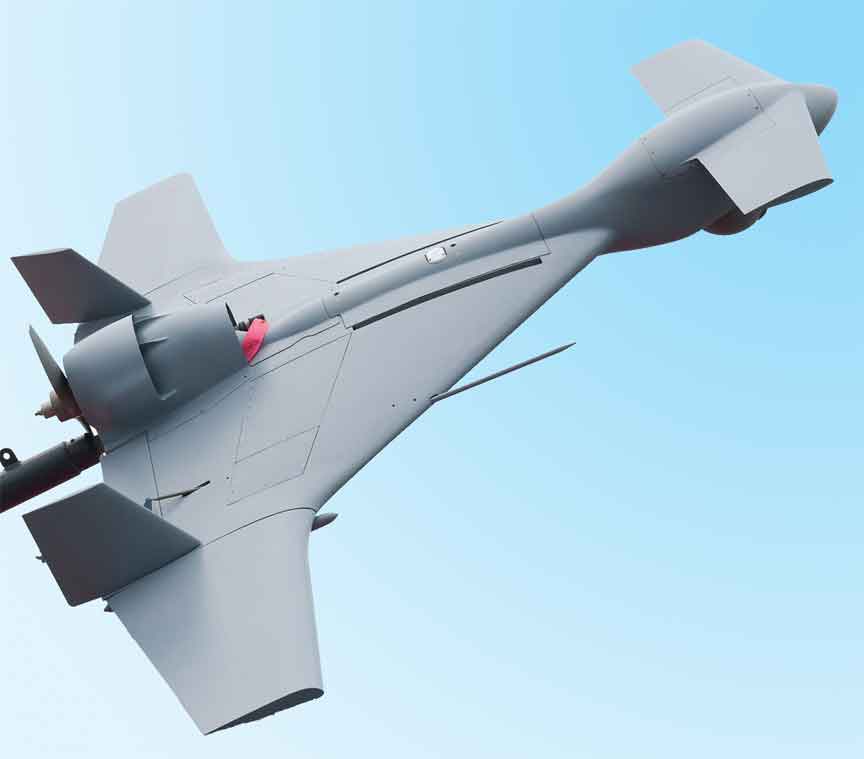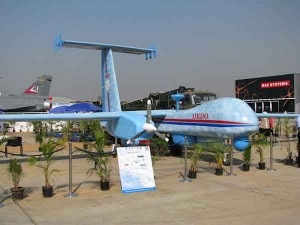Proliferation of UAVs in all Domains
UAVs are today used by nearly 90 countries, with a few of these manufacturing their own. The US is the leader with over 7,500 operational UAVs which is more than the combined strength of the rest of the world. The US is also the lead manufacturer with Israel coming a close second. General Atomics, Northrop Grumman, Israeli Aircraft Industries (IAI) and Elbit Systems are world’s leading manufacturers. IAI’s Harpy, Harop, Searcher and Heron are flying the world over in large numbers, including in India. Elbit’s Hermes 450 assault UAV carries two missiles.
The USA is the leader with over 7,500 operational UAVs which is more than the combined strength of the rest of the world…
Miniature UAVs as small as a few millimetres in size are being used for visual and audio snooping operating in small confines such as rooms or bunkers. UAVs currently operate at altitudes of 65,000 feet, at ranges of 5,600 km and endurance of up to a few days-on-station. Most UAVs are fixed-wing aircraft, but Rotary-winged UAVs (RUAV) such as Northrop Grumman MQ-8B Fire Scouts are also in use.
Technologically, UAVs are still more accident prone and are bandwidth hogs. Global Hawks require nearly 500 megabytes per second. The USAF predicts every conceivable aircraft role could be handled by UAVs by 2030 including that of Airlift, AWACS and Counter Air Strikes. By 2030, the Royal Air Force (RAF) estimates, a third of the force will be unmanned aircraft. China has over 40 different types among a fleet of 1,500 UAVs. ‘Anjian’ (Dark Sword) is a Global Hawk class Chinese HALE UAV.
WZ-2000 is a twin-jet powered delta winged high-altitude long-endurance UAV similar in size to the US General Atomics MQ-9 Reaper. Developed in Pakistan, ‘Burraq’ (Chinese UCAV design) and ‘Shahpar’ surveillance UAVs were inducted in late 2013.
Manned vs Unmanned
Taking the pilot out means no more need for life support, seats, control systems, readouts or even something as simple as a latch that opens from the inside. All that weight and space is saved. This allows the UAV to be much smaller and lighter. The UAV of the future will be able to accelerate and turn in a way that would be lethal for a human pilot. The proliferation and success of UAVs have caused some to question the future of manned aircraft in the future. This has been more so due defence budget cuts and competing demands for scarce resources. Manned craft are best in contested environments where command and control is limited, autonomy is required and policy restrictions exist. Everywhere else, the UAV will dominate.
Collateral damage from UAV attacks continues to be high at 32 per cent…
Jet pilots argue that the data links can be denied or deceived. The threat of cyber-attack today is more potent than the threat from Al Qaeda. Delays/break in command guidance could be crucial if not lethal. As it stands, till date, unmanned aircraft have flown only in uncontested airspace. As US military focus shifts to the Asia-Pacific, the Air Force could be confronted by sophisticated enemy fighters in unfriendly skies, a mission some feel UAVs are not yet designed to handle. The accident rate of UAVs in the USAF is 0.9 per 10,000 hours, still much worse than 0.2 per 10,000 for manned aircraft. But UAV safety records are improving quickly. At approximately $75 million, the Global Hawk, a Class III HALE UAV, is costlier than many a modern fighter.
Collateral damage from UAV attacks continues to be high at 32 per cent. In Pakistan, UAVs have reportedly killed 50 civilians for every militant killed – a hit rate of two per cent. While cockpit crew have reduced over the years, before an unmanned airliner becomes a reality, the air traffic control system would have to reinvent itself to be dealing with robots relying less on human judgement and interaction and more on mechanical systems. Pilots do not make up much of the cost of running an airliner, unions would not be happy with eliminating them, and the public do not seem very keen about flying alone. Even a plane that can fly itself may have a human pilot aboard for emergencies and reassurance.
Small UAVs could be used as air taxis to ferry people from city centre to the main airport. By 2020, a single crew on the ground or air will be able to control multiple UAVs at once. Humans will be given an alert when critical decision is required. Every time an airman is replaced by a machine, the operator cuts down the cost of recruitment, salary, health benefits and accommodation. Currently, unmanned systems require no less than manned aircraft to operate but the numbers are going down. Resistance by manned crew is similar to that was by the horse cavalry when the armoured tank was introduced.
India: Time to Get the Act Right
In India, UAVs are being operated by the three services and intelligence agencies for border sanitisation, incursion management, coastal security, target lasing, battle damage assessment and ISR functions. They are also being used in Naxal-prone areas for tracking movements and directing security forces. India is looking at more sophisticated large footprint systems such as the RQ-4 Global Hawks. The Indian Ministry of Defence (MoD) has issued a global Request for Proposal for procuring 95 mini-unmanned UAVs for the IAF and Indian Navy. India’s Defence Research and Development Organisation (DRDO) is developing a stealth UCAV named ‘AURA’ for the IAF. It will be similar in design to Northrop Grumman ‘B-2 Spirit’ and will be capable of releasing missiles and precision bombs. DRDO’s ‘Rustam’ UAV is meant to replace the Israeli ‘Heron’ in all three services one day.
India is looking at more sophisticated large footprint systems such as the RQ-4 Global Hawks…
The Indian Armed Forces operate nearly 150 mid-sized UAVs and many more handheld ones. India needs to push its ‘Make in India’ initiative for UAVs. Mumbai and New Delhi police are on the verge of acquiring UAVs. Aviation may come to the rescue of India’s dismal population-to-police ratio of 130 to every 100,000. The Hindustan Aeronautics Limited (HAL) along with DRDO’s Aeronautical Development Establishment (ADE) and National Aeronautical laboratory (NAL) at Bangalore have developed mini and micro UAVs of three-kilogramme class. HAL designers are working on eight to ten kilogramme UAVs, which are expected to receive certification by early 2016. India’s indigenous capability has to be built up through a leapfrog by joining up with Israel, the world leader in UAV technology.
The Future Is Unmanned
UAVs have more than proven their value in the military world. In Libya, an American drone identified and attacked the convoy Colonel Gaddafi was travelling in. A few hours later, after fleeing, he was caught by rebels and killed. By January 2014, the US Armed Forces operated a large number of UAVs: 7,362 RQ-11B Ravens; 145 Aero Vironment RQ-12A Wasps; 1,137 Aero Vironment RQ-20A Pumas; 306 RQ-16 T-Hawk Small UAS systems and 246 Predators and MQ-1C Grey Eagles; 126 MQ-9 Reapers; 491 RQ-7 Shadows; and 33 RQ-4 Global Hawk large systems.
The MQ-9 Reaper costs $12 million while an F-22 costs over $120 million. We are in a real time of transition and many believe that the F-35 Joint Strike Fighter will be the last manned fighter/bomber. Solar Powered Unmanned Aerial Vehicles will be one of the major technological advances in the near future. Dual use interchangeable aircraft have already been tested and could be optionally manned. AeroVironment Company’s Raven, Puma AE and Wasp systems set the standard for what SUAS which can be launched quickly to provide precise situational awareness.
Many believe that the F-35 Joint Strike Fighter will be the last manned fighter/bomber…
UAVs also ensure no ‘public opinion sensitive’ body bags come back. This could also mean that seemingly clean and safe strikes could allow America to perpetually be at war beyond Congressional scrutiny with no-boots-on-the-ground. NATO logisticians hit a major milestone in Afghanistan, reaching out when an unmanned K-Max helicopter successfully delivered a slingload of beans, bullets, and Band-Aids to an unspecified base for the first time.
UAVs will also perform the role of low-cost test platform for future aircraft serving as a bridge between wind tunnels and manned flight testing of a wide array of high risk technologies. Currently, the solar-powered Zephyr holds the endurance record for UAVs, with 14 days in the air but efforts are being made to extend the airborne duration to as long as five years. Agriculture and mapping industries are expected to buy most UAVs in the coming years. Blood banks will be able to deliver bottles in emergencies using drones.
In 2013, the US Navy launched a UAV from a submerged submarine. In July, 2015, A NASA Langley fixed-wing Cirrus SR22 aircraft was flown remotely from the ground. In 2015, the US Navy tested swarm behaviour with nine small Coyote drones. In October 2014, the Linux Foundation and leading technology companies launched the open source Drone-code Project to meet the needs of the growing UAV community with a neutral governance structure.
The IAF needs to envision this future and build up its UAV numbers; India needs to get its act right for UAV production…
Data link jamming attacks would be the weapon of the future. Decision makers must take into account the possible use of UAVs by terrorists or unfriendly regimes. Western companies are developing lasers to damage or knock down UAVs, but these could also fall into unwanted hands. UAVs can be brought down through hard kill. With increase in aviation density, mid-air collision risk needs attention. There have been cases of small drones being ingested in an airliner engine. UAVs are being designed to fly to an area of interest avoiding collisions within the swarm. They will automatically process imagery requests and will detect threats and targets by using artificial intelligence says USAF vision document. UAVs may one day carry nuclear weapons.
By 2030, flying robots could be programmed with automatic target engagement logic and would open fire only after going through a checklist of preset engagement rules. By 2047, the USAF foresees fewer pilots and much more stand-alone UAVs. Air Superiority will remain the main mission with UAVs, UCAVs, satellites and Cruise Missiles being increasingly employed to reinforce the manned aircraft and the missile. The IAF needs to envision this future and build up its UAV numbers; India needs to get its act right for UAV production.






